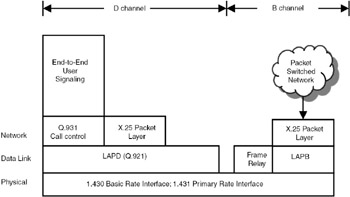27.5 ISDN PROTOCOL ARCHITECTURE
|
| < Day Day Up > |
|
27.5 ISDN PROTOCOL ARCHITECTURE
ISDN supports both circuit-switched and packet-switched operations, and the protocol architecture takes care of both types of operations. In addition, signaling-related protocols are also specified. In ISDN, the signaling between the ISDN switches is done through SS7 signaling, discussed in the previous chapter.
The ISDN protocol architecture is shown in Figure 27.4.

Figure 27.4: ISDN protocol architecture.
Physical Layer
The physical interface is based on X.21 for interfacing to a public circuit switching network through an 8-pin connector. Specifications provide for capabilities to transfer power across the interface (generally from network to terminal). Just as the PSTN telephone is supplied the power (-48 V) from the switch, ISDN switch is also capable of this function. ITU-T Recommendation I.430 specifies the physical layer functionality for BRI, and Recommendation I.431 specifies the physical layer functionality for PRI.
Data Encoding
Basic rate is 192kbps using the pseudoternary encoding scheme, in which binary 1 is represented by an absence of voltage and 0 is represented by a positive or negative pulse of 750 mV with 10% tolerance. Primary rate is 2.048Mbps, with 2.048Mbps with AMI with HDB3 encoding scheme.
Datalink Layer
The protocol structure is different for B and D channels. For D channel, LAPD, based on HDLC, is used. All transmission on D channel is based on LAPD frames, exchanged between subscriber equipment and switch for three applications: (a) control signaling to establish, maintain, and terminate connection on B channel; (b) packet switching services to the subscriber; and (c) telemetry. The LAPD frame format, shown in Figure 27.5, is derived from HDLC.

Figure 27.5: LAPD frame format.
| Note | The datalink layer protocol used for D channel is called LAPD (link access protocol D channel) which is derived from HDLC. |
The LAPD frame consists of one byte of flag, two bytes of address, two bytes of control information, a variable number of bytes of user information, two bytes of FCS, and one byte of flag.
The differences between HDLC and LAPD are:
-
LAPD always uses 7-bit sequence numbers (3-bit sequences are not allowed).
-
FCS (frame check sequence) is always a 16-bit field for CRC.
-
The address field for LAPD is a 16-bit field that contains two subaddresses: one to identify one of possibly multiple devices on the user side of the interface and the other to identify one of possibly multiple logical users of LAPD on the user side of the interface.
LAPD is specified in Recommendation Q.931.
For B channel, circuit switching and semi-permanent circuits are supported. From the ISDN viewpoint, for circuit switching, there is no need for layers 2 to 7 and hence they are not specified.
ISDN protocol architecture addresses the first three layers of the ISO/OSI model. Layers 4 to 7 are not the concern of this protocol architecture. Using these protocols, circuit-switched and packet-switched calls can be established.
For packet switching, once a circuit is set up through the D channel, X.25 layers 2 and 3 can be used for virtual circuit data transfer. At the datalink layer in the protocol architecture, Frame Relay is also shown. This is used in the broadband ISDN applications.
Network Layer
The network layer for packet switching applications is based on X.25. For call control (signaling) the Q.931 recommendation is followed.
In ISDN protocol architecture, layers 4 to 7 of the ISO/OSI model are not specified, because ISDN is not concerned about these details. ISDN provides facility only to establish circuit-switched and packet-switched calls at the specified data rates. Any type of user application can be developed using this infrastructure.
|
| < Day Day Up > |
|
EAN: 2147483647
Pages: 313